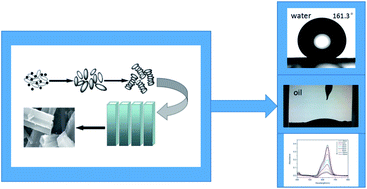Oils and solvable organic pollutants in wastewater demand separations of the components along with efficient photocatalysis in water treatment. Herein, we report on a practical purification strategy by using the multifunctional nickel-dimethylglyoxime [Ni(DMG)2] microtubes to separate the liquid mixture and degrade organic pollutants. The self-assembled [Ni(DMG)2] tubes was synthesized by a facile co-precipitation method. The static contact angle of the film prepared by mixing [Ni(DMG)2] powder (1 : 2 wt%) into polydimethylsilicone (PDMS) to water can reach 161.3°, which can still remain superhydrophobic but oil-friendly under corrosion conditions. PDMS imparts good mechanical properties and serves as both the adhesive and hydrophobic material. PFOTS methanol solution contains a large number of low surface energy groups, which can reduce the surface free energy of [Ni(DMG)2] rough structure. The superhydrophobic rough surface prepared by hollow micron tubular [Ni(DMG)2] samples must have both low surface energy substance and hollow micron tubular morphology. Due to the unique wettability, oil and water were efficiently separated from the oil–water mixture through the films. The coated film itself is photocatalytic in degrading quinoline blue, rhodamine B, methyl orange and methylene blue. By using the film's multifunctionality, a practical wastewater treatment was realized via water–oil separation, followed by fast photocatalytic degradation of solvable dyes.

